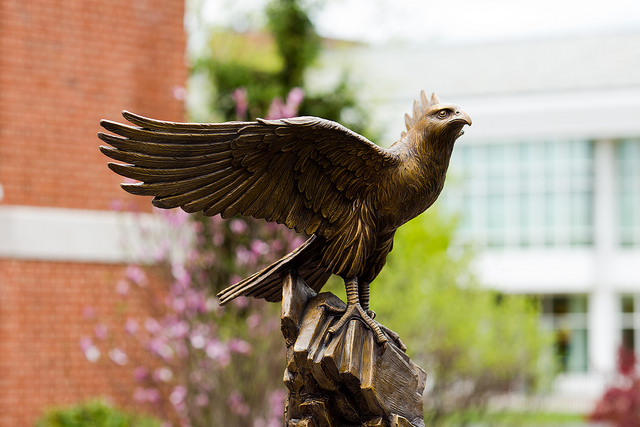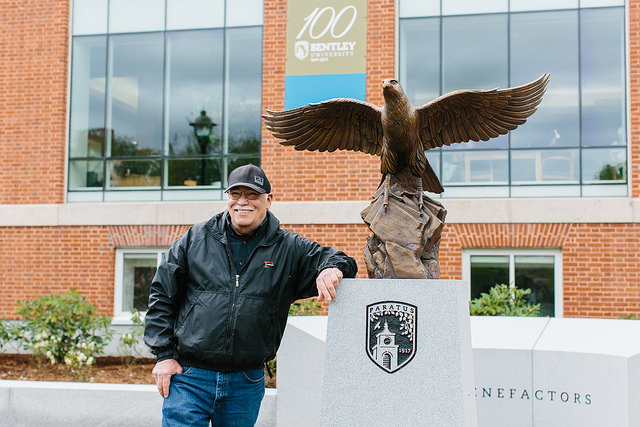
Clear eyes. Wings spread. Talons firmly planted. The newest addition to the Bentley campus is a soon-to-be iconic sculpture of the university’s beloved mascot. The falcon was commissioned to honor the centennial and was installed on May 8 behind the library.
With Bentley’s new campus in the early 1960s came the first university mascot: the beaver. But not for long. Within a year, the falcon took its place. Since the first statue appeared behind the library, alumni have affectionately topped its head with straw reunion hats, students have draped scarves around its wings during Homecoming and countless families have posed by its side on commencement day.
From the first sketch to the final bronze cast, the new sculpture took six months to create — but it will live on to inspire the next 100 years of Bentley.
How did it come to be? Let’s ask its creator.
A Shure Commission
You know Robert Shure’s work; you just might not know Bob. The Bentley falcon is in good company — almost the entire wild kingdom, in fact, including the turtles, crabs and herons at the Spaulding Rehabilitation Hospital healing garden.
Shure also created the famous FAO Schwartz teddy bear that welcomed generations of children to the toy  giant’s flagship Boston store and later to the Floating Children’s Hospital at Tufts New England Medical Center. Shure’s daughter, Lisa Benson, was the first kid to climb into the bear’s sturdy arms after its installation.
giant’s flagship Boston store and later to the Floating Children’s Hospital at Tufts New England Medical Center. Shure’s daughter, Lisa Benson, was the first kid to climb into the bear’s sturdy arms after its installation.
And the next time you’re at the Washington Monument, take a look at the profile of George above the entrance, and the president’s bronzed quote. Another Shure commission, it won him a Design Achievement Award from the Department of the Interior that, he says, quite humbly, “is really cool, like a Nobel in my field.”
Originally from New York, Shure studied at the School of Museum of Fine Arts and Tufts University before becoming the last apprentice to Adio di Biccari and Arcangelo Cascieri, two Italian American sculptors in downtown Boston. After di Biccari and Cascieri passed away, Shure took over the studio and moved it to Woburn, where it became the family business: Skylight Studios.
After hundreds of commissions, Shure still can’t believe his luck. “I’m a senior citizen, but I still work seven days a week, 12 hours a day,” he says. “I do what I love every day.” From researching each unique piece and its history to sketching the designs, from sculpting the smaller clay models to the full-scale versions, every request brings something new: like a centennial falcon.
“This is my first falcon,” Shure says of the Bentley sculpture. He modeled the bird to stand dramatically atop book-shaped stones. “My subtle nod to fit the Bentley theme.”
After creating what he calls a “maquette,” a full-size metal and plaster armature built to support the clay, he then spent weeks sculpting the model. Unlike sculptors who take a large stone and chisel in, Shure works from the inside out. Once the clay model was done, a negative mold was made to cast a wax copy. In the process, the clay was destroyed and the wax was molded for the bronze which was cast in pieces and welded together.
Not many people have a favorite type of rock. Shure’s is granite — for its beauty and permanence. “Softer stones like limestone or marble, they don’t hold up to the weather,” he says. “All of the sculptures I do, including this falcon, are cast in bronze and combined with granite. Granite endures forever.”
Certainly, we hope, until the next Bentley centennial.

